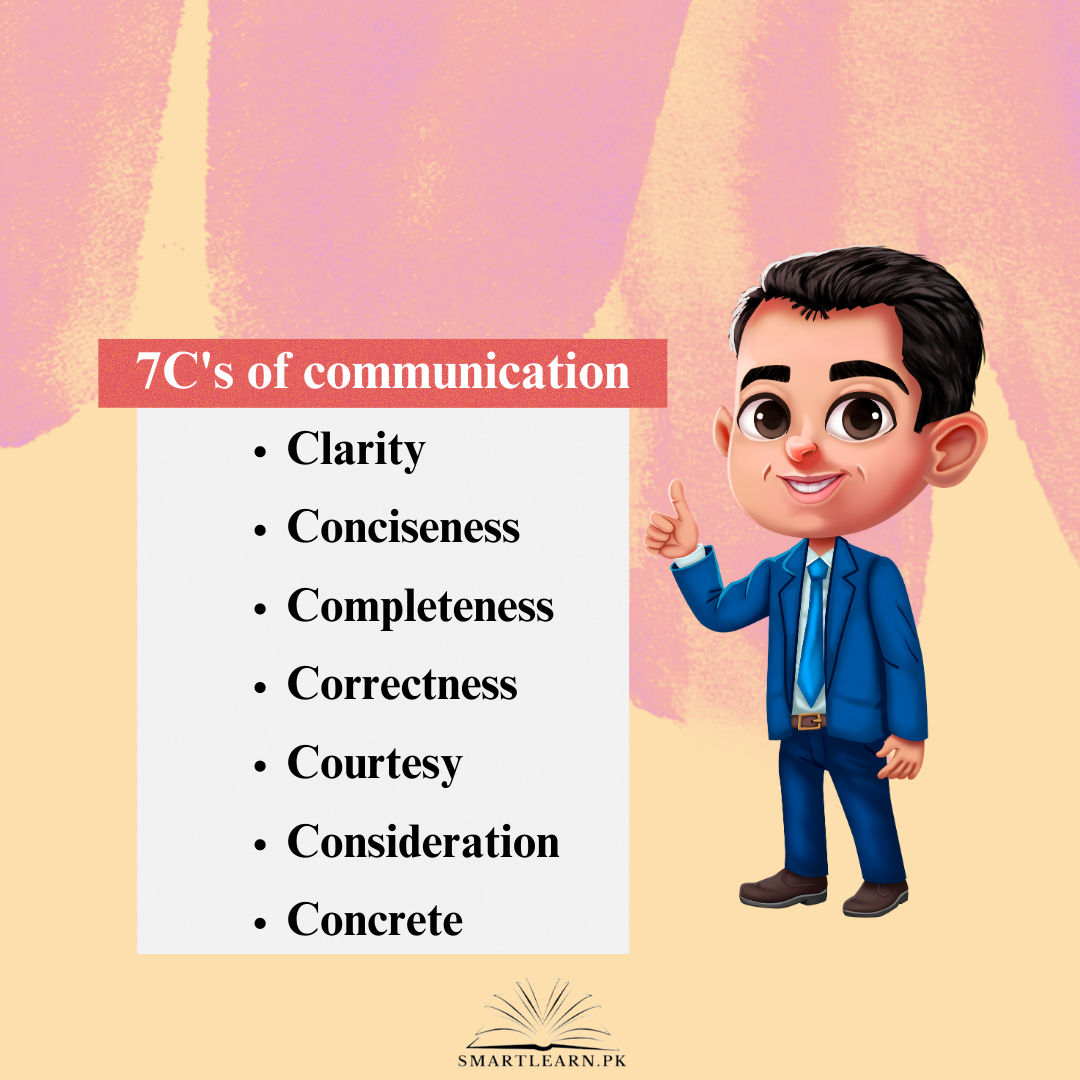
Consider how frequently you engage with others throughout the day. You may draft emails, conduct meetings, contribute to conference calls, generate reports, develop presentations, discuss topics with coworkers, and so forth.
Given that we can devote a substantial portion of our day to communication, it follows that communicating with clarity and effectiveness can increase productivity.
Thus, the 7 Cs of Communication can be advantageous. The 7 Cs offer a framework to ensure that your meetings, emails, conference calls, reports, and presentations are well-organized and comprehensible – allowing your intended audience to understand your message.
Importance
The 7 Cs of communication are important because they provide a set of guidelines for effective communication. By following these principles, communicators can ensure that their message is clear, concise, complete, correct, courteous, considerate, and concrete.
Clear communication helps to avoid misunderstandings, confusion, and errors, while concise communication helps to save time and resources. Completeness ensures that all necessary information is conveyed, while correctness builds trust and credibility with the audience. Courtesy and consideration help to create positive relationships and foster goodwill, while concreteness helps to ensure that the message is specific and tangible.
The 7C’s of Communication
- Clarity
- Conciseness
- Completeness
- Correctness
- Courtesy
- Consideration
- Concreteness
Clarity
The clarity in communication means that your message is expressed clearly and is easy to understand. It involves using simple and straightforward language, and avoiding technical terms or jargon that may be unfamiliar to your audience. A clear message helps the listener or reader to grasp the information more easily and reduces the chances of misinterpretation or confusion. Clarity in communication is essential to ensure that your intended message is effectively conveyed to your audience.
Example
“Please meet me at the reception desk at 2:00 PM tomorrow for the team meeting.”
This message is clear and easy to understand because it uses simple and straightforward language. It communicates a specific time, place, and purpose for the meeting. There is no ambiguity or confusion about what is expected of the recipient, making it easy for them to act on the message.
Conciseness
Conciseness in communication refers to the ability to express your message using as few words as possible, while still conveying the intended meaning effectively. It involves eliminating any unnecessary information or repetition and presenting the information in a clear and direct manner. Conciseness in communication helps to keep your audience’s attention focused on your message and prevents them from becoming bored or distracted by irrelevant information. Additionally, it saves time for both the speaker and listener, making communication more efficient and productive.
Example
“Meeting at 2 PM tomorrow.”
This message is concise because it conveys the necessary information in just four words. It provides the time and purpose of the meeting, while eliminating any unnecessary information. This makes the message easy to read and understand, while also saving time for both the sender and the recipient.
Completeness
Completeness in communication means providing all the necessary information required for your audience to fully understand your message. It involves ensuring that your message contains all the relevant details, facts, and figures necessary for your audience to make informed decisions or take appropriate action. Incomplete messages can lead to misunderstandings, confusion, or even incorrect decisions, which can have serious consequences. Providing a complete message helps to ensure that your audience has all the information they need to fully comprehend your message and take the appropriate course of action.
Example
“Please find attached the monthly sales report for March. It includes a summary of our sales by region, a breakdown of our top-performing products, and an analysis of our sales trends over the past year. Please review the report and let me know if you have any questions or concerns.”
This message is complete because it provides all the necessary information the recipient needs to fully understand the message. It includes the purpose of the message, what is attached, and a detailed description of what the attachment contains. It also invites the recipient to ask questions or provide feedback, ensuring that they have all the information they need to make informed decisions.
Correctness
Correctness in communication refers to the accuracy of the message being conveyed. It means that the information provided is factually correct, free from errors or omissions, and presented in a manner that is consistent with the intended purpose of the message. Inaccurate or incorrect information can lead to misunderstandings, misinterpretations, and incorrect decisions. Correctness is essential in ensuring that the intended message is conveyed accurately and that the recipient of the message can trust the information provided. This requires the speaker to pay close attention to grammar, spelling, and punctuation, as well as to ensure that the content is consistent with the intended purpose.
Example
“The budget for the project is $50,000, as approved by the board of directors on March 15th, 2022. This budget includes all estimated costs for materials, labor, and equipment.”
This message is correct because it provides accurate and precise information. It cites the source of the information (the board of directors) and the date of approval, which adds to its credibility. It also provides a clear and specific description of what the budget covers, leaving no room for ambiguity or misinterpretation.
Courtesy
Courtesy in communication refers to being polite, respectful, and considerate towards the audience you are communicating with. It involves showing appreciation for their time, opinions, and feelings and being mindful of their cultural background or personal circumstances. Being courteous in communication helps to establish a positive and productive relationship between the speaker and the listener. It also helps to ensure that the message is received in a positive manner and that the recipient is more likely to act on the message as a result. Showing courtesy can include using appropriate language, addressing the audience in a respectful manner, and being attentive to their needs and preferences.
Example
“Dear Ms. Johnson,
I hope this message finds you well. I wanted to thank you for taking the time to meet with me last week to discuss the new project. Your insights and suggestions were incredibly valuable, and I appreciate your willingness to share your expertise. If you have any further thoughts or ideas, please do not hesitate to reach out to me.
Best regards,
John”
This message demonstrates courtesy because it is polite and respectful in tone. It acknowledges the recipient’s time and effort, and expresses gratitude for their contributions. It also invites further communication, indicating that the sender values the recipient’s input and is open to further collaboration.
Consideration
Consideration in communication means being mindful of the audience’s needs, interests, and preferences when delivering your message. It involves taking into account their background, knowledge, and experience and adapting your communication style to ensure that your message is well-received. Being considerate in communication helps to establish a positive and productive relationship between the speaker and the listener. It also helps to ensure that the message is relevant and meaningful to the recipient, increasing their engagement and motivation to act on the message. Consideration can include tailoring your message to the audience’s level of understanding, using examples that are relevant to their experience, and acknowledging their feedback and opinions.
Example
“Dear Employees,
I wanted to remind everyone that the office will be closed on Monday for Memorial Day. I hope you all have a relaxing and enjoyable long weekend with your families and friends. If you have any urgent work that needs to be completed before the holiday, please let me know so we can make arrangements.
Thank you and have a great weekend!
Sincerely,
Management”
This message demonstrates consideration because it shows that the sender is thinking about the needs and interests of the recipients. It acknowledges the holiday and encourages the employees to take time off to rest and recharge. It also offers support for any urgent work that needs to be completed before the holiday, showing that the sender is willing to accommodate the employees’ needs.
Concreteness
Concreteness in communication refers to the ability to provide specific, tangible, and factual information in your message. It involves using vivid, descriptive language and providing concrete examples to illustrate your point. A concrete message is more memorable and easier to understand because it is based on real and tangible experiences. It also helps to prevent misinterpretations and misunderstandings that may arise from vague or abstract language. Concreteness in communication helps to establish credibility and trust with your audience, as it demonstrates your knowledge and expertise on the topic. It can also increase the likelihood that your audience will take action based on the message.
Example
“Please order 100 units of the XYZ product by Friday, April 30th. The order should be shipped to our main warehouse at 123 Main St., Anytown, USA. The cost per unit should not exceed $50, and we require a 30-day payment term.”
This message is concrete because it provides specific and detailed information. It clearly specifies the quantity, product, deadline, shipping address, and cost per unit. It also includes a payment term, which provides clarity on the financial aspect of the transaction. This level of detail ensures that both the sender and the recipient have a clear understanding of the expectations and requirements for the order.
